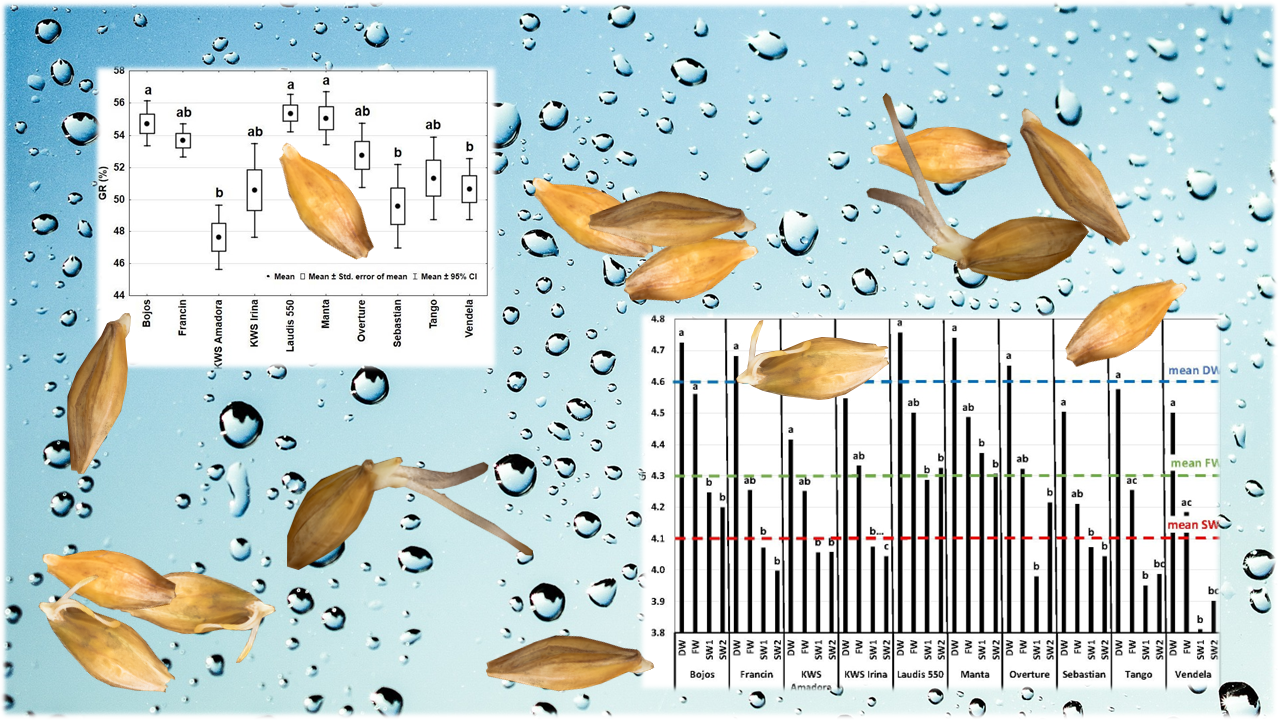Germination of malting barley grains when using recycled steep-out water
DOI:
https://doi.org/10.18832/kp2022.68.647Keywords:
germination, grain quality, grain vigour, variety, provenienceAbstract
The objective of the study was to quantify the inhibitory effect of repeated use of steep-out water on selected germination parameters. Ten malting barley genotypes from three sites were tested in this research. Statistically significant inhibitory effects of recycled steep-out water on germination rate GR (reduction by 22.8% on average compared to distilled water), germination index GI (reduction by 10.9% on average compared to distilled water), as well as germination energy GE (reduction by 2.4% on average compared to distilled water) were recorded. Compared to the average GI of all varieties in distilled water (4.6), GI was lower by 6.7% and 6.1% for Laudis 550, 5.0% and 6.3% for Manta, but 14.1% and 13.3% for Tango, and 17.2% and 15.2% for Vendela when water from the first and second steeps was used. The varietal differences identified, as well as the effect of provenience, indicated different levels of GI reduction depending on the vigour of the caryopsis. Caryopses of the genotypes with higher vigour are able to cope better with the inhibitory effect of the steep-out water on germination.
References
Anandan, A., Mahender, A., Prasad, S.R., Lotan, K.B., Hatanath, S., Jitendra, M., Janga, N.R., Jauhar, A. (2020). Non-destructive phenotyping for early seedling vigor in direct-seeded rice. Plant Methods, 16, 127. https://doi.org/10.1186/s13007-020-00666-6
EBC Analysis Committee (2010). EBC Analytica, 3.7 – Germinative Percentage and Germinative Indices of Barley. Nürenberg: Fachverlag Hans Carl, 2010, p. 794. ISBN 978-3-418-00759-5
EUROMALT (2022). How is malt made? [online]. https://www.euromalt.be/malt-1 [2022-07-25].
Frančáková, H., Líšková, M. (2009). Dormancy of malting barley in relation to physiological parameters of barley grain. Acta Fytotechnica et Zootechnica, 12, 20–23.
Frantová, N., Rábek, M., Elzner, P., Středa, T., Jovanović, I., Holková, L., Martinek, P., Smutná, P., Prášil, I.T. (2022). Different drought tolerance strategy of wheat varieties in spike architecture. Agronomy, 12, 2328. https://doi.org/10.3390/agronomy12102328
Guiga, W., Boivin, P., Ouarnier, N., Fournier, F., Fick, M. (2008). Quantification of the inhibitory effect of steep effluents on barley germination. Process Biochemistry, 43(3), 311–319. https://doi.org/10.1016/j.procbio.2007.12.001
Horáková, V, Dvořáčková, O. (2017). Seznam doporučených odrůd 2017. Ústřední kontrolní a zkušební ústav zemědělský Brno. ISBN 978-80-7401-142-9
Chloupek, O., Ehrenbergerová, J., Ševčík, R., Pařízek, P. (1997). Genetic and non-genetic factors affecting germination and vitality in spring barley seed. Plant Breeding, 116, 186–188. https://doi.org/10.1111/j.1439-0523.1997.tb02176.x
Chloupek, O. (2008). Genetická diverzita, šlechtění a semenářství. Academia Praha, p. 307. ISBN 978-80-200-1566-2
Justé, A., Malfliet, S., Lenaerts, M., de Cooman, L., Aerts, G., Willems, K.A., Lievens, B. (2011). Microflora during malting of barley: Overview and impact on malt quality. BrewingScience, 64(3), 22–31.
Klimešová, J., Středa, T., Středová, H. (2013). Maize transpiration in response to meteorological conditions. Contributions to Geophysics and Geodesy, 43(3), 225–236. https://doi: 10.2478/congeo-2013-0014
Kocková-Kratochvílová, A., Lukášová-Novotná, M. (1959). Polyphenolic substances in malt steeping water. Kvasny Prumysl, 5(7), 153–160. https://doi.org/10.18832/kp1959018
Kunze, W. (2004). Download Technology Brewing and Malting. VLB Berlin, Germany. ISBN 3-921-690-49-8
Lazarova, E., Klimesova, J., Streda, T. (2016). Seed vigour and root system size as an attribute for drought escape and tolerance. Proceeding of International PhD Students Conference MendelNet 2016, Brno, Czech Republic, 9–10 November 2016, 102–105.
Lehner, A., Mamadou, N., Poels, P., Come, D., Bailly, C., Corbinea, F. (2008). Changes in soluble carbohydrates, lipid peroxidation and antioxidant enzyme activities in the embryo during ageing in wheat grains. Journal of Cereal Science, 47, 555–565. https://doi.org/10.1016/j.jcs.2007.06.017
Longlong, F., Tiangang, H., Boxiao, W., Benhua, Z. (2021). Assessment of rice seed vigour using selected frequencies of electrical impedance spectroscopy. Biosystems Engineering, 209, 53–63. https://doi.org/10.1016/j.biosystemseng.2021.06.011
Loock, M.M., Beukes, J.P., van Zyl, P.G. (2015). Conductivity as an indicator of surface water quality in the proximity of ferrochrome smelters in South Africa. Water SA, 41(5), 705–711. https://dx.doi.org/10.4314/WSA.V41I5.14
Matthews, S., Powell, A.A. (1986). Environmental and physiological constraints on field performance of seeds. Hort Science, 21, 1125–1128.
Mavi, K., Mavi, F., Demir, I., Matthews, S. (2014). Electrical conductivity of seed soak water predicts seedling emergence and seed storage potential in commercial seed lots of radish. Seed Science and Technology, 42, 76–86. http://dx.doi.org/10.15258/sst.2014.42.1.08
Nagel, M., Kodde, J., Pistrick, S., Mascher, M., Börner, A., Groot, S.P.C. (2016). Barley Seed Aging: Genetics behind the Dry Elevated Pressure of Oxygen Aging and Moist Controlled Deterioration. Frontiers in Plant Science, 7, 388. https://doi.org/10.3389/fpls.2016.00388
Prokeš, J., Hartmann, J. (2005). Dormancy of the selected varieties of malting barley in 2001-2004. Kvasny Prumysl, 51(10), 334–341. https://doi.org/10.18832/kp2005015
Psota, V. (2017). Ječmenářská ročenka 2017. Praha: Výzkumný ústav pivovarský a sladařský, p. 107. ISBN 978-80-86576-76-3 243
Psota, V., Šusta, J., Kosař, K. (1998). Homogeneity and modification of malt II. Grain germination, beer flavour. Kvasny Prumysl, 44(5), 126–129. https://doi.org/10.18832/kp1998010
Rhoades, J.D., Kandiah, A., Mashali, A.M. (1992). The use of saline waters for crop production. FAO Irrigation and Drainage, FAO Rome, 48. ISBN 92-5-103237-8
Samarah, N., Alqudah, A. (2011). Effects of late-terminal drought stress on seed germination and vigor of barley (Hordeum vulgare L.). Archives of Agronomy and Soil Science, 57, 27–32. https://doi.org/10.1080/03650340903191663
Senaratna, T., Gusse, J.F., McKersie, B. (1988). Age-induced changes in cellular membranes of imbibed soybean seed axes. Physiologia Plantarum, 73, 85–91. https://doi.org/10.1111/j.1399-3054.1988.tb09197.x
Středa, T., Cerkal, R., Hájková, L., Chuchma, F., Khel, T., Klimešová, J. (2020). GIS application in abiotic risks regionalization for spring barley. Contributions to Geophysics and Geodesy, 50(1), 49-60. https://doi.org/10.31577/congeo.2020.50.1.3
Tomer, R.P.S., Maguire, J.D. (1990). Seed vigour studies in wheat. Seed Science and Technology, 18(2), 382–392.
Uçarlı, C. (2020). Effects of Salinity on Seed Germination and Early Seedling Stage. In: S. Fahad et al. (eds.), Abiotic Stress in Plants, IntechOpen, London. https://doi.org/10.5772/intechopen.93647
Ullmannová, K., Středa, T., Chloupek, O. (2013). Use of barley seed vigour to discriminate drought and cold tolerance in crop years with high seed vigour and low trait variation. Plant Breeding, 132(3), 295–298. https://doi.org/10.1111/pbr.12065
Vintrlikova, E., Klimesova, J., Streda, T. (2015). Possibility of selection for higher seed vigour of barley. Proceeding of International PhD Students Conference MendelNet 2015, Brno, Czech Republic, 11–12 November 2015, 99–102.
Woonton, B.W., Jacobsen, J.V., Sherkat, F., Stuart, I.M. (2005). Changes in germination and malting quality during storage of barley. Journal of The Institute of Brewing, 111(1), 33–41. https://doi.org/10.1002/j.2050-0416.2005.tb00646.x
Zhang, T., Fan, S., Xiang, Y., Zhang, S., Wang, J., Sun, Q. (2020). Non-destructive analysis of germination percentage, germination energy and simple vigour index on wheat seeds during storage by Vis/NIR and SWIR hyperspectral imaging. Spectrochimica Acta Part A: Molecular and Biomolecular Spectroscopy, 239, 118488. https://doi.org/10.1016/j.saa.2020.118488

Downloads
Published
How to Cite
Issue
Section
License
Copyright (c) 2022 Natálie Březinová Belcredi, Radim Cerkal, Ivana Jovanović, Jhonny Edison Alba Mejía, Psota Vratislav, Hana Středová, Tomáš Středa

This work is licensed under a Creative Commons Attribution 4.0 International License.







